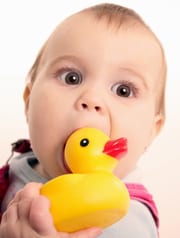Environment Canada seeks information on phthalates for priority assessment
 The current Canadian regulation for phthalates as it applies to children’s products is SOR/2010-298. The regulation covers phthalates DEHP, DBP and BBP in the vinyl components of a toy or child care article not to exceed 1,000 mg/kg or 1,000 ppm (0.1% by weight) and phthalates DINP, DIDP and DNOP in the vinyl components of a toy or child care article that in a “reasonably foreseeable manner, be placed in the mouth of a child under four years of age” not to exceed 1,000 mg/kg or 1,000 ppm (0.1% by weight).
The current Canadian regulation for phthalates as it applies to children’s products is SOR/2010-298. The regulation covers phthalates DEHP, DBP and BBP in the vinyl components of a toy or child care article not to exceed 1,000 mg/kg or 1,000 ppm (0.1% by weight) and phthalates DINP, DIDP and DNOP in the vinyl components of a toy or child care article that in a “reasonably foreseeable manner, be placed in the mouth of a child under four years of age” not to exceed 1,000 mg/kg or 1,000 ppm (0.1% by weight).
The requirement of this regulation is very similar to the one in the U.S. under the CPSIA which covers both toys and child care articles.
On July 13, 2013, Environment Canada issued a notice to manufacturers and importers directing them to provide information about their use of phthalates in food and beverage contact materials along with other consumer products. Through this notice the government has listed more than 30 phthalate substances which will undergo priority assessment through its Chemicals Management Plan. Environment Canada has asked for details about the manufacture, importation and use of the substances “for the purposes of assessing whether [they] are toxic or capable of becoming toxic, or for the purpose of assessing whether to control [them].”
As a U.S. based manufacturer or distributor to the Canadian market, your Canadian based importer will likely make inquiries of your product if “during the 2012 calendar year, [they] imported a total quantity greater than 100 kg [220 lbs.] of a substance listed in Schedule 1 of this notice, at a concentration equal to or above 0.001% by weight (w/w%) [10 ppm]”
The key for children’s products manufacturers and distributors;
(b) in a manufactured item that is
(i) intended to be used by or for children under the age of six years, or (ii) intended to come into contact with the mucosa of an individual, other than eyes, or (vi) clothing or footwear, or (vii) furniture intended to be used in a residence, or a furnishing intended to be used in a residence if the substance is contained in a textile
If you know or might know that your products fall within this range you and your importer would have to respond to this notice by November 13, 2013. Failure to submit the required information would subject companies to fines and/or jail terms under the Canadian Environmental Protection Act.

